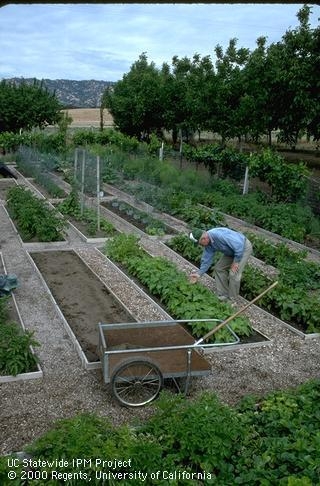UC Master Gardeners, SLO County, a resource for gardeners
- Author: Chris Cocchiaro
Published on: April 20, 2010
General Gardening Sustainability

By Dale Norrington
Q We so often hear the word sustainable these days, from various sources and seemingly with various meanings. We do care about the environment but are not in a position to completely renovate our landscape and garden. Can the Master Gardeners offer an approach to sustainable gardening, or some specific practices which we can begin to use right away?
Paul and Mary Kubacki - San Luis Obispo
A An approach to sustainable landscaping recommended by the University of California Cooperative Extension includes practices developed by the Sacramento Stormwater Quality Partnership with permission and assistance from StopWaste.org in Alameda County.
Most gardeners should be able to implement these practices immediately and relatively easily, and save energy, water, time and money.

Benefits of sustainable practices can be felt in our own households; the environment benefits from such practices adopted throughout watersheds, and the cumulative effects may be significant.
Landscape in harmony with natural conditions of the site, watershed and climate.
Maintain fire safe landscaping, protect local flora and fauna, and utilize site-adapted plants, ideas for which can be seen at Cal Poly's Leaning Pine arboretum and at
http://arboretum.ucdavis.edu/arboretum_all_stars.aspx
* Landscape for less to the landfill
Use plants of sizes which match their intended space to reduce pruning; grasscycle; compost; and incorporate salvaged hardscape materials where possible.
* Nurture the soil
Save topsoil, mulch, avoid use of quick-release inorganic fertilizers and use pesticides as a last resort.
* Conserve water
Minimize turf, group plants according to water needs, and maintain efficient irrigation systems.
* Conserve energy
Plant trees to minimize energy use. Shade paved areas. Shade south and west sides with deciduous trees. Design outdoor lighting carefully.
* Protect water and air quality
Utilize Integrated Pest Management; minimize impervious surfaces; prevent runoff; use appropriate equipment.
* Create and protect wildlife habitat
Maintain diverse plantings and utilize natives. Provide water and shelter. Conserve or restore natural areas and wildlife corridors.
Please contact Master Gardeners for much more related information and detail.
Got a Question?
Contact the University of California Cooperative Extension Master Gardeners: at 781-5939 from 1 to 5 p.m. on Monday and Thursday; at 473-7190 from 10 a.m. to noon in Arroyo Grande; and at 434-4105 from 9 a.m. to noon on Wednesday in Templeton. Visit the UCCE Master Gardeners Web site at groups.ucanr.org/slomg/ or e-mail mgsanluisobispo@ucdavis.edu.

By Dale Norrington
Q We so often hear the word sustainable these days, from various sources and seemingly with various meanings. We do care about the environment but are not in a position to completely renovate our landscape and garden. Can the Master Gardeners offer an approach to sustainable gardening, or some specific practices which we can begin to use right away?
Paul and Mary Kubacki - San Luis Obispo
A An approach to sustainable landscaping recommended by the University of California Cooperative Extension includes practices developed by the Sacramento Stormwater Quality Partnership with permission and assistance from StopWaste.org in Alameda County.
Most gardeners should be able to implement these practices immediately and relatively easily, and save energy, water, time and money.

Benefits of sustainable practices can be felt in our own households; the environment benefits from such practices adopted throughout watersheds, and the cumulative effects may be significant.
Landscape in harmony with natural conditions of the site, watershed and climate.
Maintain fire safe landscaping, protect local flora and fauna, and utilize site-adapted plants, ideas for which can be seen at Cal Poly's Leaning Pine arboretum and at
http://arboretum.ucdavis.edu/arboretum_all_stars.aspx
* Landscape for less to the landfill
Use plants of sizes which match their intended space to reduce pruning; grasscycle; compost; and incorporate salvaged hardscape materials where possible.
* Nurture the soil
Save topsoil, mulch, avoid use of quick-release inorganic fertilizers and use pesticides as a last resort.
* Conserve water
Minimize turf, group plants according to water needs, and maintain efficient irrigation systems.
* Conserve energy
Plant trees to minimize energy use. Shade paved areas. Shade south and west sides with deciduous trees. Design outdoor lighting carefully.
* Protect water and air quality
Utilize Integrated Pest Management; minimize impervious surfaces; prevent runoff; use appropriate equipment.
* Create and protect wildlife habitat
Maintain diverse plantings and utilize natives. Provide water and shelter. Conserve or restore natural areas and wildlife corridors.
Please contact Master Gardeners for much more related information and detail.
Got a Question?
Contact the University of California Cooperative Extension Master Gardeners: at 781-5939 from 1 to 5 p.m. on Monday and Thursday; at 473-7190 from 10 a.m. to noon in Arroyo Grande; and at 434-4105 from 9 a.m. to noon on Wednesday in Templeton. Visit the UCCE Master Gardeners Web site at groups.ucanr.org/slomg/ or e-mail mgsanluisobispo@ucdavis.edu.

S-GA-SCEN-SB013
Viewing -3--3 of 1



